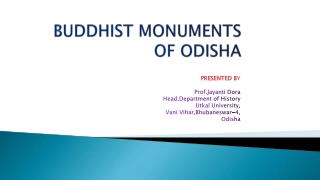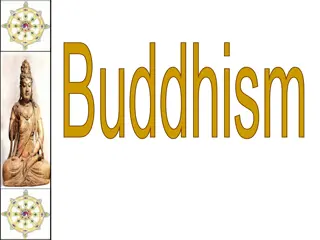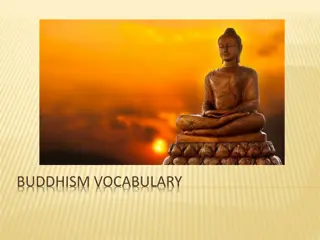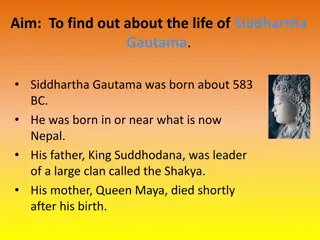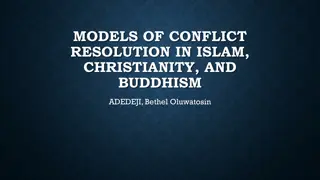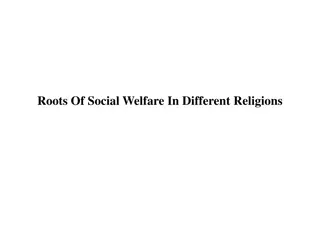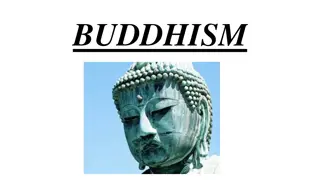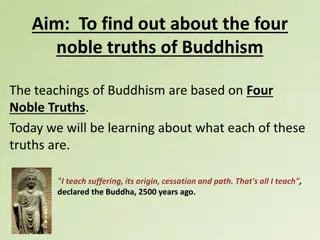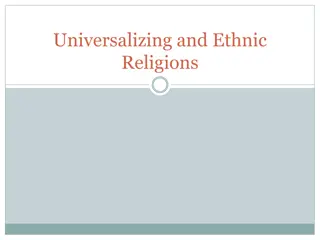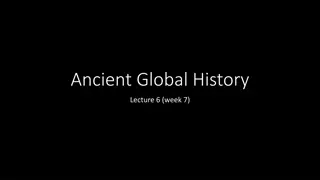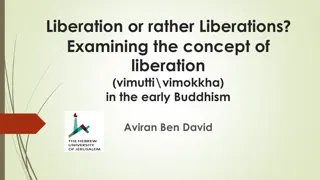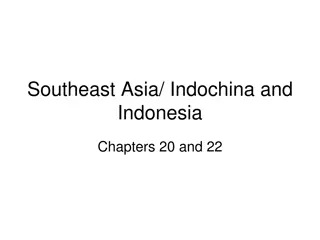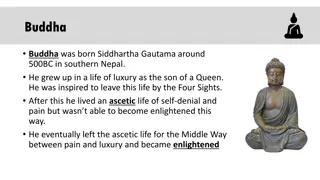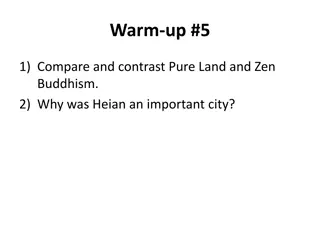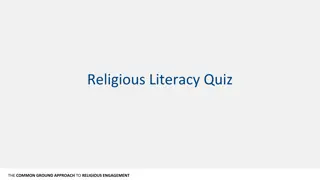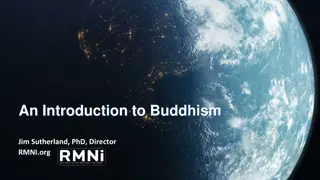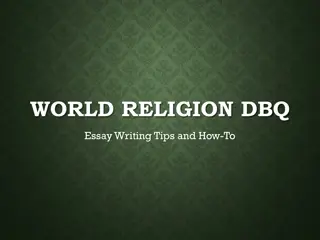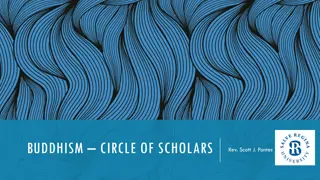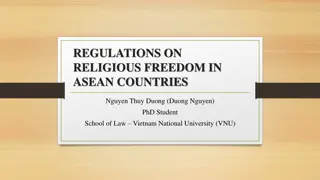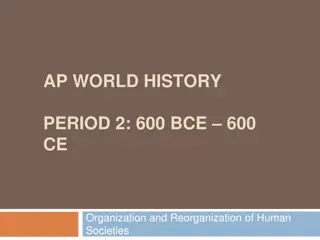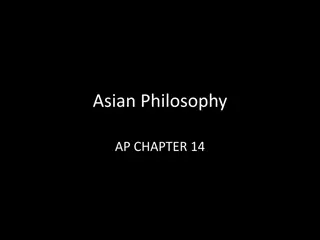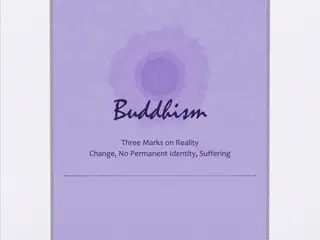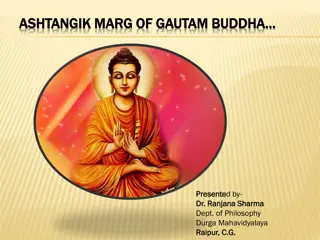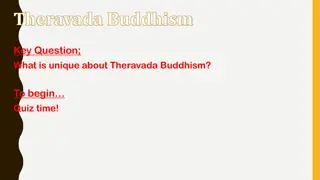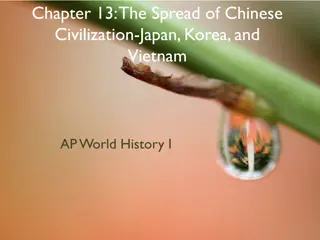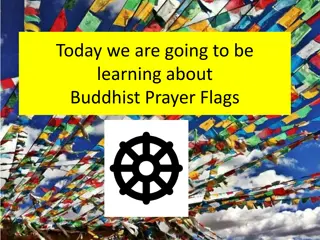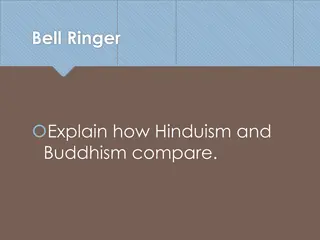Prof. Jayanti Dora's Insight on Buddhism - A Historical Perspective
Explore the profound impact of Buddhism as a religious and moral movement in ancient times through the teachings and enlightenment of Gautama Buddha. Discover the essence of the Four Noble Truths, the significance of reincarnation, and the architectural structures associated with Buddhist practices.
0 views • 72 slides
Higher RMPS Revision Tasks with a Focus on Buddhism
Engage in various revision tasks related to Buddhism, such as creating timelines, exploring key beliefs, understanding the importance of the Buddha, and delving into concepts like Samsara and Kamma. Dive deep into Buddhist practices and concepts to enhance your understanding and preparation.
0 views • 35 slides
A Comparison of Hinduism and Buddhism in Ancient Indian Religions
Hinduism and Buddhism, two major religions originating in ancient India, share beliefs in concepts like moksha and reincarnation but differ in practices, gods, texts, and societal impacts. Hinduism's caste system influences all aspects of life, while Buddhism was founded by Siddhartha Gautama, the B
2 views • 11 slides
The Pala Empire: Rise and Patronage of Buddhism
The Pala Empire, known for its significant expansion and patronage of Mahayana Buddhism, saw key rulers like Gopala, Dharmapala, and Devapala leading to a cultural flourishing with establishments like Vikramashila and Nalanda universities. Noted Buddhist scholars from this period include Atisha and
2 views • 15 slides
The Psychology of Flow: Achieving Total Focus and Optimal Performance
Engage in activities for their intrinsic value, where the ego diminishes, and time seems to vanish - that's when flow occurs. This optimal psychological state involves deep concentration, clear goals, and a sense of control. By embracing challenges and staying in the present moment, one can cultivat
0 views • 13 slides
Understanding Buddhism: Teachings, History, and Beliefs
Explore the essence of Buddhism through its teachings, history, and the story of Siddhartha Gautama. Learn about the Four Noble Truths, the concept of nirvana, and the Eightfold Path to achieve enlightenment. Compare Buddhism with Hinduism to understand the differences and similarities between these
0 views • 28 slides
Understanding Key Concepts of Buddhism
This content provides an overview of essential vocabulary, key figures like Siddhartha Gautama, the founder of Buddhism, and core teachings such as the Four Noble Truths and the Eightfold Path. It delves into concepts like meditation, Nirvana, and the pursuit of enlightenment, offering insights into
0 views • 8 slides
The Life of Siddhartha Gautama: A Journey to Enlightenment
Siddhartha Gautama, born around 583 BC in Nepal, was destined for greatness. Despite being shielded from the harsh realities of life, he was deeply moved by the suffering he witnessed and left his luxurious life at the palace in search of enlightenment. Renouncing his princely status, Siddhartha bec
0 views • 7 slides
Models of Conflict Resolution in Islam, Christianity, and Buddhism
Conflict resolution is essential for peaceful solutions in disagreements. This discourse explores models of conflict resolution in Islam, Christianity, and Buddhism, emphasizing the importance of dialogue, good intentions, and reconciliation across diverse beliefs and cultures.
0 views • 32 slides
Perspectives on Social Welfare in Different Religions
Christianity emphasizes mercy and kindness through personal charity and structural societal changes. Hinduism promotes selfless service, compassion, and mutual aid. Buddhism focuses on equality, charity, and environmental stewardship to uplift society.
1 views • 8 slides
Ancient Heterodoxies: Buddhism and Other Radical Ideas in the 6th to 4th Centuries BCE
Explore the Age of Heterodoxies in the 6th to 4th Centuries BCE, focusing on Buddhism, Jainism, and other radical ideologies challenging orthodox beliefs. Learn about the key figures like Buddha and Mahavira, their teachings, and the societal implications of these heterodoxies. Uncover how these ide
0 views • 16 slides
Insights into Buddhism: History, Philosophy, and Schools
Buddhism, a spiritual tradition focused on personal development and attaining deep insight into life, boasts 376 million followers globally. Rooted in the teachings of the Buddha, it emphasizes reaching nirvana through morality, meditation, and wisdom. The history of Buddhism traces back to Siddhart
0 views • 33 slides
Understanding the Four Noble Truths of Buddhism
The teachings of Buddhism are centered around the Four Noble Truths revealed by the Buddha 2500 years ago. These truths encapsulate the core principles of suffering, its origins, cessation, and the path to liberation. Each truth delves into the nature of human suffering, the root causes of desires a
0 views • 8 slides
Religions and Assisted Dying: An Overview
Explore the intersection of religions and assisted dying, discussing key aspects such as the meaning of religions, views on death, perspectives on assisted dying across various religious traditions, and the lack of explicit support for assisted dying in most religions. The overview also delves into
0 views • 12 slides
A Comparative Study of Universalizing and Ethnic Religions
Understanding the differences between universalizing and ethnic religions, the main tenets of Christianity, Islam, Buddhism, and Hinduism, along with their geographic distribution. Explore the concepts of universalizing vs. ethnic religions and the branches within them.
0 views • 11 slides
Understanding Shintoism: The Essence of Japanese Devotion to Kami and Rituals
Shintoism is a Japanese religion centered around devotion to kami, invisible spiritual beings and powers, and engaging in rituals at shrines. It focuses on fostering a connection between human beings and kami through practices rather than belief systems. Shintoism emphasizes local community ties, et
0 views • 30 slides
The Axial Age: Pivotal Thinkers Across Ancient Civilizations
The Axial Age, coined by Karl Jaspers, refers to a period from the 8th to 3rd century BCE where pivotal thinkers emerged independently in Persia, India, China, Greece, and Rome, shaping the spiritual foundations of humanity. Jaspers, a German philosopher and psychiatrist, highlighted the importance
2 views • 21 slides
Exploring Liberation in Early Buddhism: Vimutti and Vimokkha Concepts
This research delves into the concept of liberation (vimutti\vimokkha) in early Buddhism through examining key sources such as Nikayas and descriptions of arahants. It discusses the significance of liberation as a final goal, different stages of liberation, defilements, noble fruits, and the various
0 views • 16 slides
Influence of Indian and Islamic Kingdoms in Southeast Asia
Southeast Asia, comprising mainland and archipelago regions, has a rich history of ancient kingdoms influenced by India and China. The Khmer Empire in Cambodia, Srivijaya in Sumatra, and the Sultanate of Malacca in Malaysia are key examples. These kingdoms evolved unique cultures blending Hinduism,
0 views • 28 slides
History of Malaysia: From Pre-history to Colonial Rule
Malaysian history traces back to the migration of Proto-Malays from China, development of trade ports, adoption of Buddhism, Hinduism, and Islam, the rise of the Malacca Sultanate, and European colonial rule by Portugal and the Dutch. The region's rich history is marked by cultural exchanges, trade
0 views • 12 slides
The Life and Teachings of Buddha
Buddha, born as Siddhartha Gautama around 500BC in Nepal, left a life of luxury to seek enlightenment after encountering the Four Sights. He eventually found enlightenment through the Middle Way, understanding the Four Noble Truths and following the Eightfold Path. His teachings on suffering, imperm
0 views • 9 slides
Japanese Cultural Influence: Buddhism, Literature, and Arts
Exploring the intersections of Buddhism, literature, and the arts in Japan during the Heian period. Comparisons of Pure Land and Zen Buddhism, the significance of Heian as a city, and the flourishing of Japanese literature and art from the 800s to the 1100s. Delve into the roles and freedoms of wome
1 views • 4 slides
Religious Literacy Quiz: Test Your Knowledge on Various World Religions
Test your knowledge about different religions with this engaging religious literacy quiz. From understanding sacred sites to key figures, holidays, and texts, challenge yourself with questions covering Christianity, Judaism, Islam, Buddhism, Hinduism, and more.
0 views • 25 slides
Introduction to Buddhism and the Life of Siddhartha Gautama
Explore the essence of Buddhism and the life of Siddhartha Gautama, who founded the religion after witnessing suffering. Buddhism has around 388 million followers globally, with its roots in India. Siddhartha Gautama's journey from a sheltered life in a palace to becoming the enlightened Buddha is a
0 views • 50 slides
Mastering World Religion DBQ Essay Writing: Tips & Steps
Explore the essential steps for crafting a compelling DBQ essay comparing and contrasting major world religions like Hinduism, Buddhism, Judaism, Christianity, and Islam. Learn how to analyze documents, formulate a thesis, structure body paragraphs, and integrate citations effectively. Dive into exa
0 views • 9 slides
Exploring Buddhism: Insights into Monastic Life and Practices
Delve into the world of Buddhism through a collection of images and resources showcasing the circle of scholars, Tibetan monks creating sand mandalas, the evolving roles of women in Buddhism, the lifestyle of Buddhist nuns, commonalities between Catholicism and Buddhism, and the daily life of a Budd
2 views • 11 slides
Regulations on Religious Freedom in ASEAN Countries
Religious freedom in ASEAN countries is explored, covering religious diversity, domestic laws, and regional/international obligations. The main religions in ASEAN are Islam, Buddhism, and Christianity. Various countries ensure the freedom to practice religions, with provisions to protect public safe
0 views • 12 slides
Development and Influence of Hinduism and Buddhism in Ancient India
Explore the development and impact of Hinduism and Buddhism in ancient India from the codification of religious and cultural traditions like the Vedas and Brahman in Hinduism to the teachings of Siddhartha Gautama (Buddha) emphasizing the Four Noble Truths and Eightfold Path. Discover how these reli
0 views • 42 slides
Exploring East Asian Philosophy: From Confucianism to Daoism and Mohism
East Asian Philosophy, encompassing Chinese, Japanese, Vietnamese, and Korean traditions, is shaped by pillars like Confucianism, Daoism, and Buddhism. This philosophical landscape evolved from a rich tapestry of ideas, including Pre-Confucian China's historical context, the teachings of Confucius,
0 views • 21 slides
Insights into Buddhism: The Three Marks of Reality and Four Noble Truths
Buddhism teaches about the Three Marks of Reality - impermanence, no permanent identity, and suffering, along with the Four Noble Truths - the existence, cause, end, and the path to release from suffering. These teachings offer profound insights on embracing change, letting go of attachments, and fi
0 views • 12 slides
Japan's Ancient History: Nara and Heian Periods
Discover the rich history of Japan during the Nara and Heian periods, from the rule of the Yamato clan to the emergence of the Heian Period as the Golden Age of Arts and Culture. Learn about influential figures like Prince Shotoku and the transition of the capital from Nara to Heian-kyo. Explore the
0 views • 14 slides
Understanding Immigration and Cultural Diversity
Explore key vocabulary related to immigration, such as push/pull factors, refugee, and naturalization. Discover different religions like Catholicism, Judaism, Islam, Hinduism, and Buddhism. Engage in map activities to learn about immigration statistics from Africa and Asia and discuss the top 3 reli
0 views • 11 slides
Exploring the Practice of Meditation in Various Spiritual Traditions
Explore the concept of meditation as described in different religious and spiritual contexts including Hinduism and Buddhism. Reflect on the significance of meditation, the benefits it offers, and how it can lead to self-improvement and spiritual growth.
0 views • 16 slides
The Eightfold Noble Path of Gautama Buddha - An Insightful Journey
Gautama Buddha, the founder of Buddhism, introduced the Ashtangik Marg or the Eightfold Noble Path comprising of eight steps to lead towards liberation from suffering. The path covers the Four Noble Truths including the causes of suffering and the way to cessation. Each step, from Right Views to Rig
0 views • 14 slides
Understanding Theravada Buddhism: Key Points and Practices
Explore the unique aspects of Theravada Buddhism including its distinctive practices such as the rejection of the Three Vehicles, the significance of Buddha Gautama, the goal of nibbana, and the teachings central to this tradition. Discover the essence of Theravada Buddhism through its emphasis on r
0 views • 4 slides
Chinese Dynasties and Philosophies: From Han to Tang
Explore the rich history of Chinese dynasties from the Han to Tang periods, including the influence of Confucianism, Buddhism, and Daoism on society and governance. Witness the rise and fall of empires, cultural blending, and the societal values that shaped ancient China.
1 views • 9 slides
The Influence of Chinese Civilization on Heian Japan
Heian Japan, ruled by the Yamato Imperial Family, experienced a cultural peak during the classical Heian period (794-1185). The Emperor, though symbolic, held sacred lineage while real power lay with the Fujiwara clan. Chinese influence shaped early Japanese culture through Buddhism, Confucianism, a
0 views • 19 slides
Understanding the Five Aggregates in Buddhism
Explore the concept of the Five Aggregates (Skandha) in Buddhism, which deconstructs the notion of a permanent self by breaking down personal identity into form, sensations, perception, mental formations, and consciousness. Through this lens, the impermanence and interconnectedness of all phenomena
0 views • 25 slides
Exploring Buddhist Prayer Flags and Tibetan Buddhism
Discover the history and significance of Buddhist prayer flags, delve into the origins of Tibetan Buddhism, and learn about the Dalai Lama's exile in Dharamsala, India. Explore the symbolism behind prayer flags, their messages of harmony and wishes, and the practice of creating your own prayer flags
0 views • 10 slides
A Comparison of Hinduism and Buddhism
Hinduism and Buddhism are two major religions originating from India with key differences and similarities. Hinduism is polytheistic and focuses on dharma, karma, and moksha, while Buddhism emphasizes the Four Noble Truths and the Eightfold Path to achieve Nirvana. Both religions advocate for spirit
0 views • 15 slides
